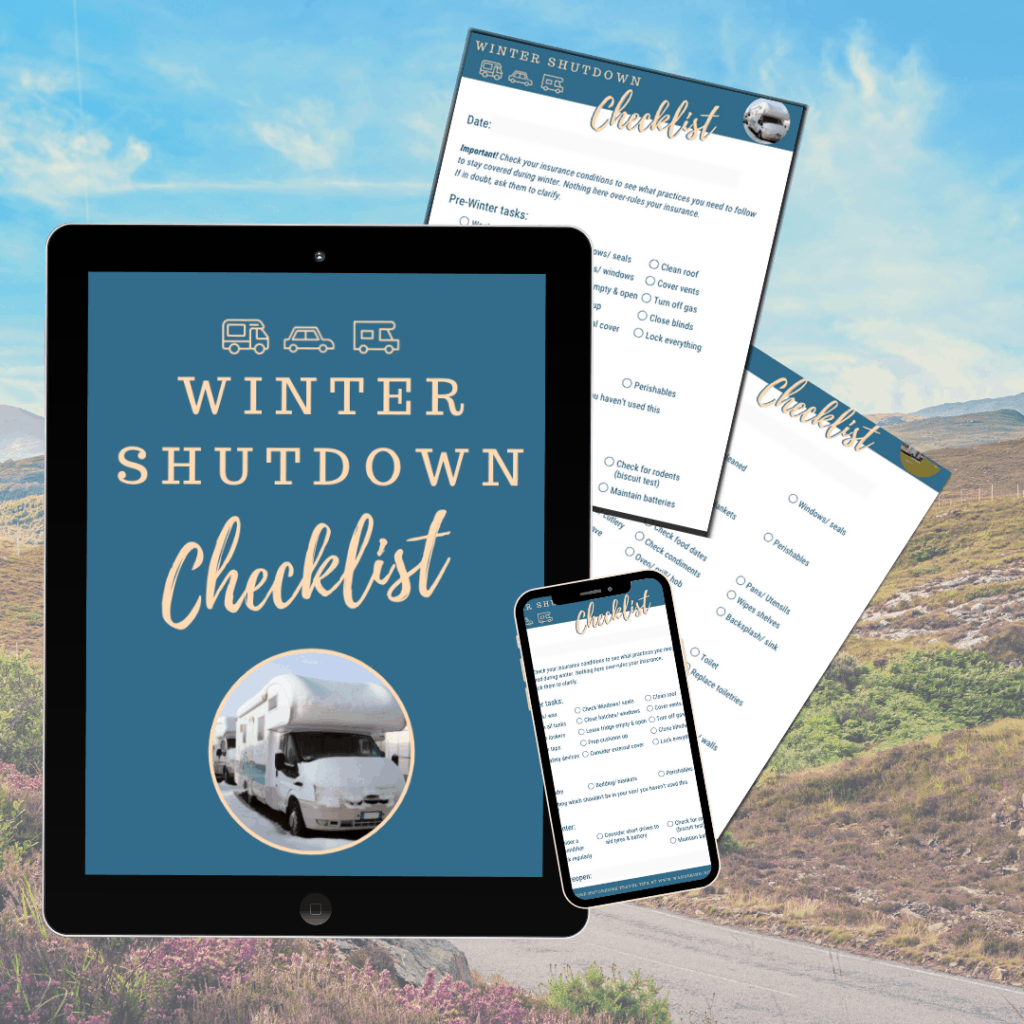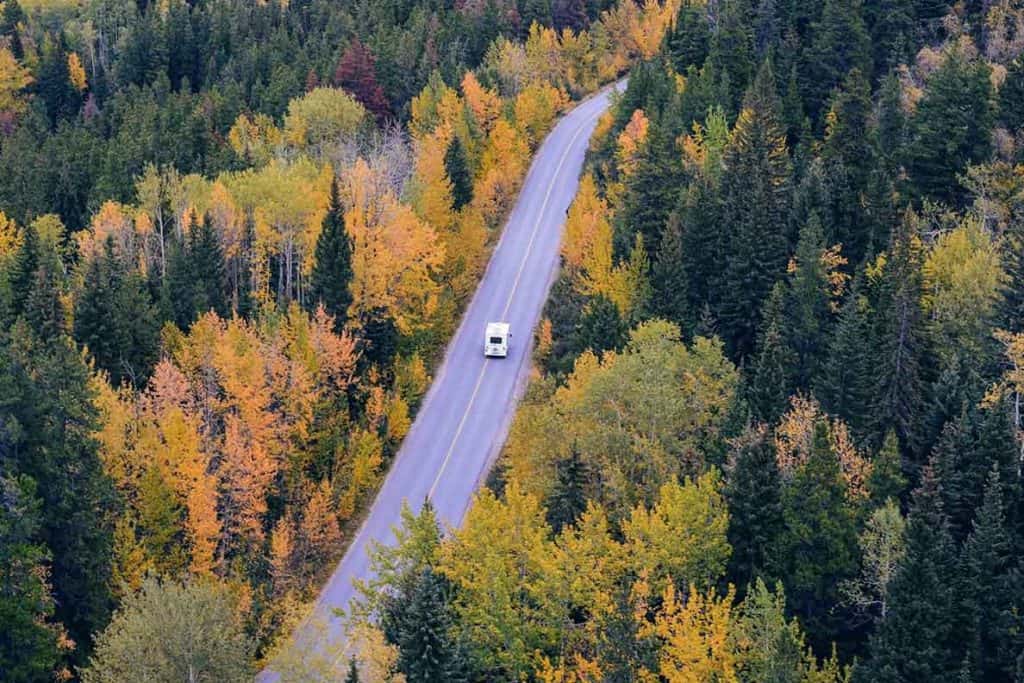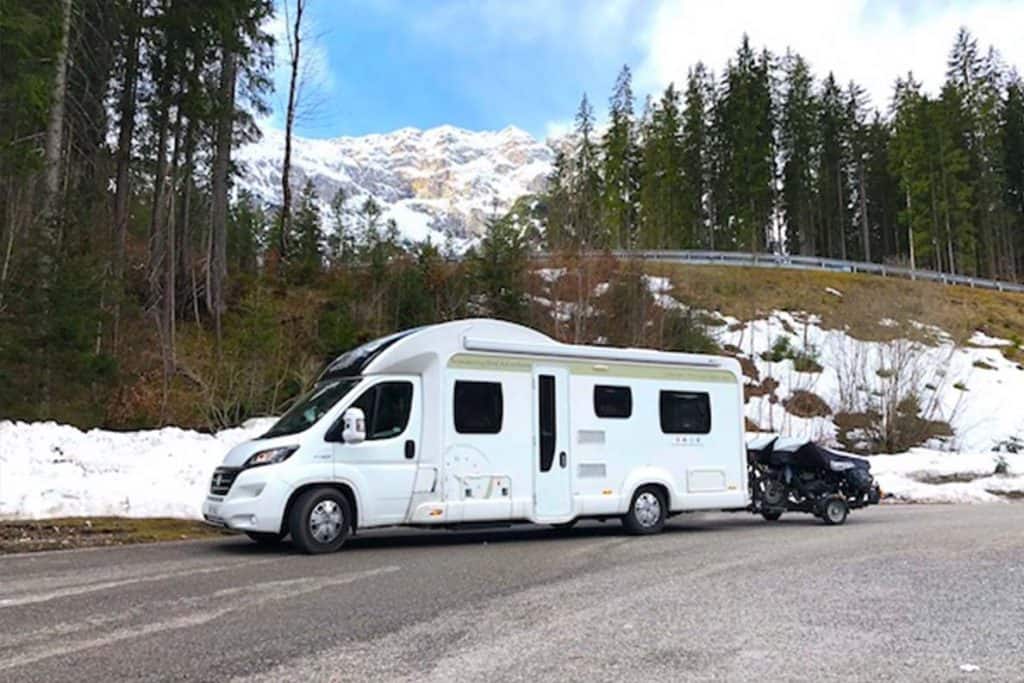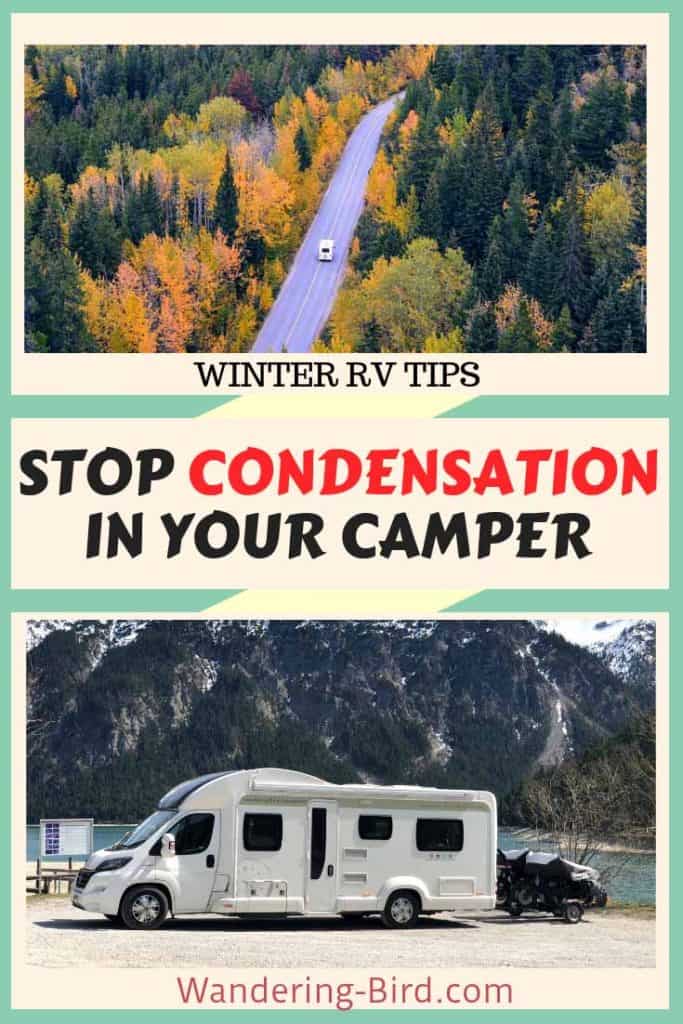Worried about condensation in your campervan, motorhome, caravan or RV? You’re in the right place- we’ve got all the best tips and tricks to reduce your vanlife damp woes.
Don’t forget to grab your FREE motorhome winter checklist below to help you remember everything.
*We work hard to make this the best motorhome travel blog and road trip website possible, full of helpful content for you. The website is supported by our readers, so if you buy through links on this site we may earn a commission- at no extra cost to you. All opinions remain our own.
If you find this post useful, you can also treat us to a coffee – we promise to enjoy it while creating more useful content like this- we might even indulge in a biscuit (or two!)
Condensation in Campervans & Motorhomes- The Problem
I love road tripping out of season. Campsites are quieter, the roads are less busy and you can go to some AMAZING places without queuing for hours.
HOWEVER- cooler weather brings one really annoying companion… condensation.
Whether you’re in a motorhome, campervan, caravan, RV or boat- you need to find ways to stop or reduce condensation or damp. Otherwise, out-of-season touring is going to become pretty miserable.
(Alternatively, just run away somewhere warm, like these 7 warmest places in Spain in winter!)
I lived on boats for 14 years before we got a motorhome, so have been doing battle against condensation for a REALLY long time. On the plus side, I’ve become really good at managing/ stopping that annoying moisture all over your windows, especially in the morning, not to mention the damp in your cupboards.
Whether you’re new to motorhomes and campervans or been doing it for a while, here are 15 of the best tips to stop condensation in your motorhome or camper, which we hope will help you enjoy trips in your van all year round.

Shutting down your motorhome/ camper for winter?
Grab your FREE winter shutdown checklist here
Condensation in a Motorhome- What Causes It?
Don’t panic- I’m not going to get technical on you.
In (very!) basic terms, condensation is caused by the volume of water in the air increasing (often because we’ve breathed it out!) This air, now full of water vapour, touches something cold, like a window.
The air is then cooled down too quickly and can’t hold the moisture in it anymore, so the vapour turns to liquid on the cold surface it’s touching.
You’ll find the most condensation in the coldest part of your van, which for us is the front cab windows as we don’t really heat that.
So, there are two main ways to get rid of campervan condensation (or at least reduce it!).
First is to reduce the amount of water vapour in the air. Second is to stop that air getting cold. Simples.

Tips to Reduce Damp and Condensation in your RV, Motorhome & Caravan
The following tips will help you either stop condensation and damp completely, or give you ways to reduce and deal with it if it does occur. Not all tips will work for every motorhome or campervan- give them all a try and see what works for you.
1- Keep your motorhome warm
This is my preferred solution to stop condensation in my motorhome and it works, although it will increase your costs.
Heating your motorhome or campervan and keeping your space at a comfortable temperature stops the air cooling down enough to cause condensation. I should point out that when it gets REALLY cold outside, this no longer works so well. 🙁
You can use an oil filled radiator if your van is plugged into mains power- these work really well and are safe to leave on for long periods, although you may wish to put it on a timer to reduce costs.
2- Open a window
A simple solution, especially if you’re living in your motorhome, but not always fun if it’s freezing/ raining!
Getting some fresh air into your motorhome allows air with less water vapour to enter, reducing the humidity and therefore reducing the level of condensation which can occur. Just be sure to pick your moments.
There’s no set rule on how long you have to have it open for- obviously the longer the better! We always open a window or a vent whenever we are cooking.
I know, this seems to contradict point one, but heating from cooking generally involves steam, which contains… you guessed it = moisture! That’s why something like a low-wattage slow cooker or an air fryer is a good idea 🙂

For the same reasons as above, if you have an extractor fitted either in your bathroom or kitchen, use it to freshen up the air, especially after a shower/ while cooking.
Showers are the hardest- so much hot, moist air which needs to go somewhere.
I leave our vents open for a couple of hours after a shower and keep the bathroom door shut as much as possible so that air doesn’t get out into the rest of the Motorhome.
4- Get a Handheld Window Vacuum cleaner
These things are GENIUS! Battery operated, easy to clean and work really well to remove condensation for windows in just a couple of minutes!
I had never heard of them before we got a Motorhome- now I’m not sure how we ever lived without one!
A window vac definitely one of the easiest ways to remove condensation from Motorhome, RV, Boat or camper windows.
My favourite brand is Karcher, but there are other types on the market- check them out here (UK)
5- Use Campsite facilities if available.
I love wild camping in our motorhome. I. LOVE. It. Pretty much any other page on this website will tell you why wild camping is preferable to campsites for me.
BUT, in winter, we use campsites a lot more.
I also use their facilities more, both for showers and for washing/ drying clothes. (See below.)
6- Don’t hang up wet clothes/ towels to dry
One way I save some money during summer is use a laundrette to wash my clothes, then hang them up in the bathroom to dry overnight. It works great.
But don’t do this in winter if you can avoid it.
All that extra moisture in the air will cause havoc for your condensation levels.
7- Can you use a dehumidifier in a motorhome or campervan?
I don’t use plug-in dehumidifier’s on the motorhome, I use stand-alone, disposable packets, like they have worked very well. I also have hanging ones, to reduce moisture in the wardrobe.
If you are looking for a dehumidifier, I’ll share some of the best ones below.
NOTE- a dehumidifier will NOT remove mildew. Once that has started, everything needs a thorough cleaning with disinfectant, and then it all needs to be dried thoroughly and left with sufficient airflow.

8- Create airflow around your camper
One thing I occasionally suffer from when living on the boat is mildew/ mould- caused by not allowing enough airflow into our cupboards/ drawers/ wardrobes. (Usually after it had been vacant for a week or more.)
For this reason, I often leave everything open/ ajar when going travelling- it stops the mildew. You can do something similar on the motorhome- either cut small holes or fit a vent to allow airflow to cupboards which don’t already have them.
Or don’t put clothes in cupboards which don’t have airflow into them. Having said that, mildew also affects paperwork and books, so be careful what you leave onboard when you’re not using your van.
9- Remember cushions and seats need love too!
You need airflow around your cushions and seats- so make sure to pull them out a little so that you don’t come back to seats covered in horrible green spots- which is damp/ mildew.
I often remove our cushions if we’re not using the motorhome for a while.
10- Put a protector over your windows
There are several ways to do this, and it works exactly like double-glazing; you have a buffer between the cold surface and the warm air inside the motorhome. I tried it when living on a boat and it worked…ok.
But it seems to work much better on the motorhome. Our coldest part is our cab, so silver or thermal screens on the exterior reduce the problem. It doesn’t stop it completely, but it does reduce it.
You can also get fun ones with eyes here.
NOTE- the pull-over fitted screens inside the cab are great for privacy, but don’t stop condensation as the air just circulates around them.
11- Keep things clean and dry
Whether you’re using your motorhome throughout winter or not, keeping your cupboards clean will definitely help to reduce damp. Damp is caused by condensation (or other moisture) sitting unchecked for too long.
It can cause serious problems for both the vehicle and your health. You can reduce the chances of damp/ mildew by increasing airflow, cleaning out cupboards and drying them thoroughly after cleaning. Your campervan storage gets easier too.
Do NOT put anything into your cupboards/ wardrobe which is damp. This includes coats and shoes. If you’re packing a motorhome, try not to put anything damp back into the cupboards.
12- Check for leaks in your campervan
It’s probably common sense, but if your van is leaking, you’re going to get more moisture into your space. Moisture= condensation when it’s warmed up, so make sure there are no leaks.
I carry a tube of silicone with us- just in case!
Common places which leak are around the motorhome tv aerial, the van wifi antenna or anything you’ve drilled, like a solar panel or awning.
Can You Use an Electric Dehumidifier in a Motorhome?
For some reason, people seem worried about using an electric dehumidifier in a motorhome. It’s perfectly safe, as long as you follow the manufacturer’s instructions and remember to empty it regularly.
Personally, I wouldn’t leave an electric dehumidifier switched on in the motorhome for a long period of time (while on a driveway for example), especially if I wasn’t there to keep an eye on it. However, it’s certainly not a problem overnight while you’re there.
You can add it to your Christmas list, along with these other perfect motorhome gifts!
Pro’s of using an electric dehumidifier in a motorhome
- Safe around pets! This is a big one for us- disposable dehumidifiers are harmful to animals if ingested.
- Easy and efficient to use
- You don’t need to worry about buying replacements
- Probably kinder to the environment, as there is less plastic wastage.
Cons of using an electric dehumidifier in a motorhome
- You need 12v or mains power & something reliable to plug it into.
- You must remember to empty it.
- It takes up space.
There are plenty of dehumidifiers on the market. Make SURE the one you are ordering has an automatic shut off when it gets full and a plug appropriate to your country (you’d be amazed how many don’t come with a plug!)
See my recommendations below.
What’s the BEST 12v Dehumidifer for a Motorhome or Campervan?
I’ll be honest (as always!) and tell you that we’ve REALLY struggled to find a reliable 12v dehumidifier for my motorhome. I’ve tried several models- and they’ve all either failed within a few days or not made any difference whatsoever.
That’s why I prefer boxes or sachets like these.
However, I am really pleased with the electric dehumidifier that we used use on the boat. They work great in the motorhome too, but obviously, you need mains to run them on.

RANDOM Bonus Tip to Stop Condensation in your Motorhome!
Ok- full disclosure- I haven’t tried this but I thought I’d share it in case it helped anyone out.
APPARENTLY, if you put a very thin coating of washing up liquid over the inside of your windows/ windscreen, it stops condensation.
My guess is the washing up liquid creates a barrier between the cold glass and warm air= reduced condensation! It sounds a bit odd to me- surely the washing up liquid smears and obstructs your vision?? And cleaning it off must be a pain.
If you’ve tried it, let me know if it works!!
So there you go, the best tips to help you stop condensation and damp in your motorhome or camper. I hope they help you enjoy trips in your van all year long.
Want more tips for motorhoming?
Here are some more ideas you might find useful:
Want FREE checklists, eBooks and additional tips to help? Visit our resource page


Last update on 2025-08-24 / Affiliate links / Images from Amazon Product Advertising API

